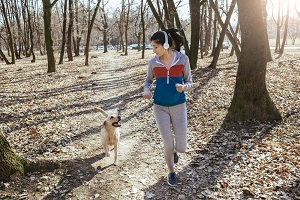MEDIA // ARTICLE

Your Dog Could Be Your Best Training Partner
February 04, 2025 at 5:00 PM EST.If you’re in the market for a new best friend, and looking for someone who shares your interest in running, a canine companion could check all your boxes.
Most dogs don’t care if it’s raining, or cold, or hot outside. If you train them correctly, they won’t be faster or slower than you; they’ll match your pace. A dog won’t skip out on you early or flake out on a scheduled run altogether. They’ll also help protect you, or at least warn you of danger in the early morning hours or out on wilderness trails. An added benefit of a dog over human partner: if you’re the type of runner who doesn’t like to chat during difficult, serious runs, they won’t talk your ear off. (And if you’re not- that’s ok too! They listen well!)
If you are interested in a puppy partner, it’s important to make sure the breed you pick out can keep up. Obviously a 4 pound Yorkshire Terrier isn’t going to do. He may be high-energy, but after about a half mile, you’ll be carrying him the rest of the way!
There are some breeds that were specifically bred to run, and those are great options. Huskies, greyhounds and most working dogs like Australian cattle dogs could be a runner’s best friend. On the other hand, snub-nosed dogs like pugs and bulldogs can’t go to the distance because they are predisposed breathing issues and overheating.
A breed who is fit for long-distance running includes Weimaraners, who are muscled, energetic dogs who needs tons of mental stimulation.
Labrador Retriever’s are a popular runner’s choice due to their lean, sturdy bodies and temperaments.
A German Shorthaired Pointer also comes to mind thanks to their reputation as an endurance athlete: they need exercise, and lots of it, every day. In fact, Outside Online even recommends German Shorthairs for cyclists looking to partner with a dog.
A surprising pick by Outside Online? The Standard Poodle. Runner’s World also endorses the pretty pooch, although they do insist that leash training is a “must”.
Whichever dog you choose to make your lifelong running partner, be sure to have him or her checked out by a veterinarian before you start your regiment. Remember that puppies may not be suitable running companions because too much activity could damage growing bones. And keep in mind that while you’re sweating, your dog isn’t. With the exception of their paws, don’t can’t sweat, which means they only way they can dissipate heat is through panting. That’s not efficient and running with a fur coat could get them in real trouble. Generally, dogs offer some pretty recognizable, nonverbal clues that it’s too much for them. Lagging behind or refusing to move is a pretty clear sign.
Veterinarians warn to watch out for worn out or sore paw pads, which could occur in any dog not used to running, especially on asphalt and concrete. They recommend sticking to grass or dirt whenever possible, and you need to watch out for sharp stones and uneven surfaces. Another tip: start out with short and slow runs until you’ve felt out your dog’s abilities.
Don’t forget water for yourself and your pooch, and remember- you need to fuel your body before and after a run, and so will your new best running partner!
